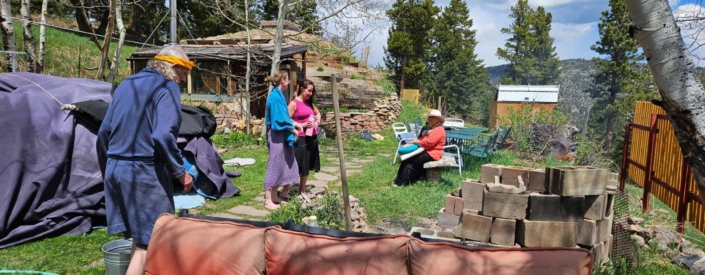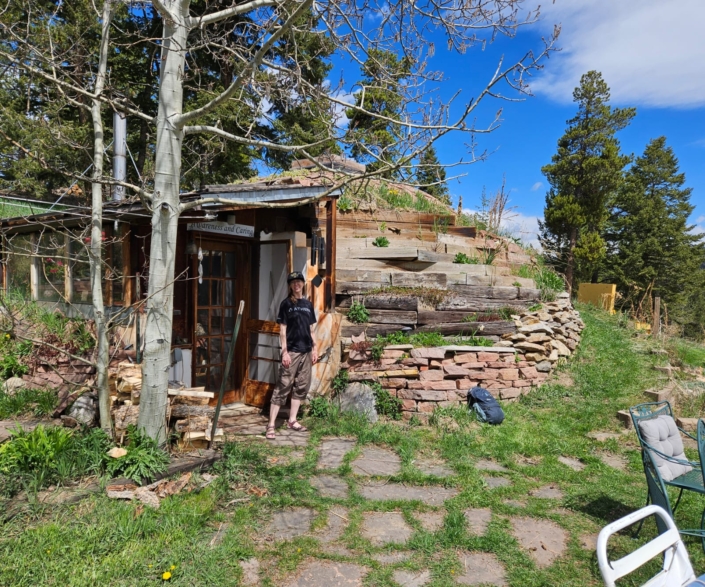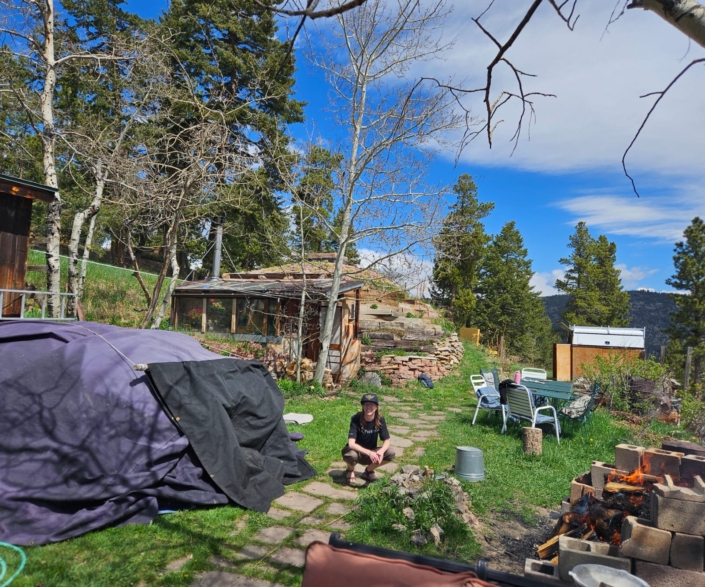A Journey of Transformation and Community Building :
How I Came to Meet Joseph Rael by Jeffery Many Hats Gold Hill Kiva In 1987, at the age of 37, I found myself caretaking an old cabin and 140 acres in Gold Hill, Colorado.
The cabin had no modern amenities—just a hand pump, an outhouse, knob-and-tube electrical wiring, and wood heat. I was also doing construction work with my all-Buddhist crew, including “Bevel Bob” Vajrayana and Doug Anderson, an ex-Rajneeshi who lived in a homebuilt shack on forest land. Our client, Deepika, was also an ex-Rajneeshi and friends with Sufis. I had read Evelyn Eaton’s book, “I Send a Voice,” which introduced me to the sweat lodge ceremony.
One day, Doug mentioned that he had picked up a Native American guy who conducted sweat lodges. This man was Eagle Elk, and I soon joined his ceremonies, held in a beautiful location by a stream. The sweat lodge ceremonies had a profound impact on me. I found solace in the concept of Wakan Tanka (Great Mysterious Power) and began praying for gratitude, healing for others, and personal transformation. I even started having vivid visions of people performing ceremonies in an underground chamber.
One day, Deepika mentioned a workshop by Joseph Rael, a Picuris Pueblo Indian. I attended the workshop, and Joseph shared stories of his culture, which deeply resonated with me. He spoke about his vision of building Sound Chambers. I realized this was akin to the underground ceremonial chambers I had been envisioning. I approached Joseph, and he announced to the group that I would build a Peace Chamber, also known as a Kiva.
The Design and the Permit I prayed at my sunset viewing power spot, asking for guidance on where to build the Kiva. The answer came: on my little 1/3 acre house plot. I moved back into my house and got roommates Andy and Anna, who were studying at Naropa University. Bevel Bob also got interested, and we decided on a “keyhole Kiva” design with a sunspace entryway and an elliptical shape.
The challenge of building the roof and getting a permit in our small, historically zoned town of 120 people loomed large. One day, I picked up my uphill neighbor Chuck, who suggested a cribbed log roof similar to those he had seen at Mesa Verde. This design involved building up square layers of logs, each at a 45-degree angle to the previous one, tapering to a square entry hole at the top.
Armed with this knowledge, I drew up plans and presented them to the Historical Board. During the meeting, after mentioning Joseph Rael’s name, a bolt of lightning struck from a nearly clear sky, and the lights went out for twenty seconds. This dramatic event convinced the board, and my permit was approved.
With the permit in hand, the construction of the Kiva began. The project faced many obstacles, from gathering materials to ensuring community support. One day, while revising my written presentation, I felt a strong urge to enter a health food store. Inside, I met Edwin, who became instrumental in peeling the Kiva log beams. Joseph continued his “jet set Shaman” routine, visiting us in Boulder between his trips to Philly and Aspen. He blessed the land with a power bundle and performed ceremonies.
The Construction of the Kiva
Financial support flowed in, and we managed to gather materials and volunteers. The volunteer crew, including a professional mason who showed up unexpectedly, helped us stack the walls and prepare for the big day of mixing and pouring the walls. Deepika built a sweat lodge, and Joseph led a ceremony with twenty or so people. Despite the small financial contributions, we decided to charge for future workshops to sustain the efforts. Joseph moved to Bernalillo and started building his Chamber there, but continued to visit us.
The Four Wishes In late 1989, while working on various construction projects in Washington state and British Columbia, I got very clear about my goals: to see Joseph and dedicate the Kiva, visit Cathy and baby Meg back east, do a retreat at my Buddhist teacher’s center, and find work out there. A powerful experience during meditation reinforced these goals, and I felt guided by a voice telling me: “The shaman you seek is through the Umatilla.” As I drove back home, passing through the Umatilla reservation and Glenwood Springs, I joined a sweat with Joseph. We arranged for him to come over on January 7, 1990, for the Kiva dedication. The dedication ceremony was profound, and Joseph introduced the Fire Ceremony, to be performed on the seventh of every month.
The Kiva Takes Shape Construction continued with the help of many volunteers. We gathered large trees for the roof, peeled and prepared them throughout the winter, and waterproofed the walls. The “all-Buddhist crew” and other volunteers worked diligently, meditating together before starting the day’s work. We decided to pour a concrete dome over the logs, which required a lot of manual labor. Women in the community gathered stones to infill the steps, adding a feminine touch to the project. We finally poured the roof, covered it with tarpaper and clay, and installed the entry windows, door, and hatch. The Kiva was complete, and we celebrated with a wood stove providing heat.
Expansion and Integration:
By 1990, I had found a balance between my construction work back east and my dedication to the Kiva. In Pennsylvania, I connected with the Bissingers and the Daly’s Peace Chamber, attending ceremonies and meeting new friends. I was promoted to superintendent, and my next job took me to Waldorf, Maryland.
In Bernalillo, Joseph’s teachings were integrated into our practices. We established elders and assistants in the four directions, created effigies for each direction, and held weekly ceremonies of chanting, prayer, and song. Challenges and Growth The journey was not without its challenges.
Jeffery Many Hats





